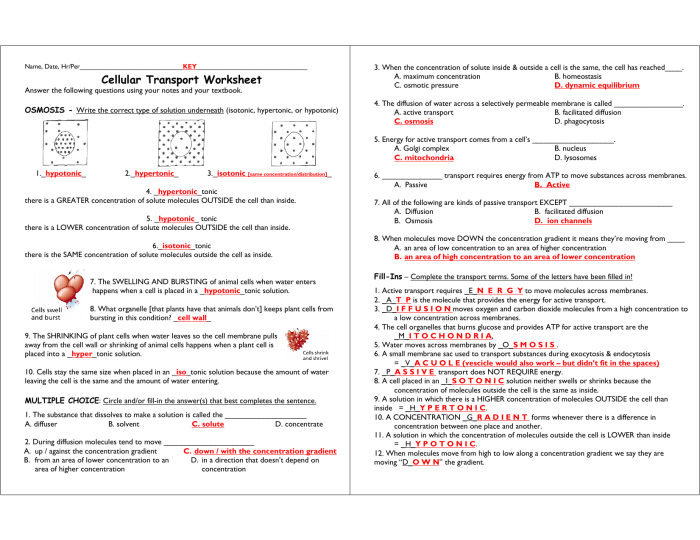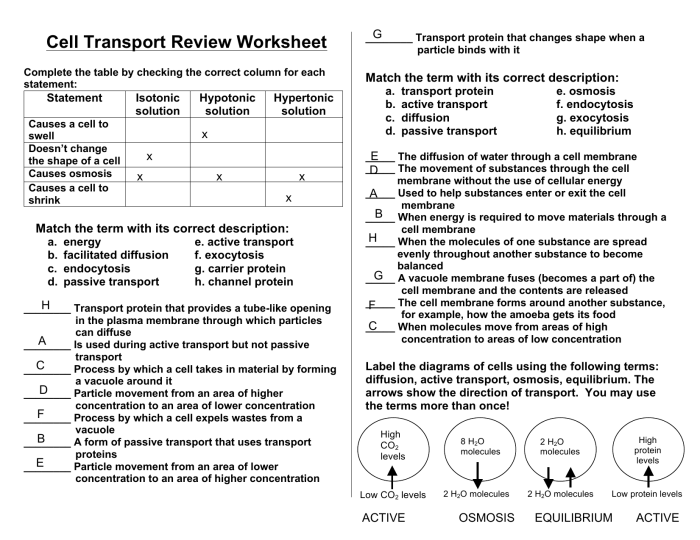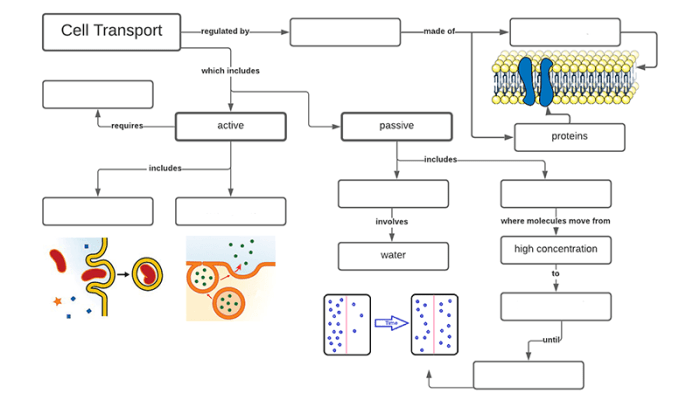Cell transport reading and questions answer key – Embark on a journey into the realm of cell transport with our comprehensive reading and answer key. Discover the intricate mechanisms that govern the movement of substances across cell membranes, shaping the very essence of life.
From passive diffusion to active transport and bulk transport, this guide unravels the complexities of cell transport, providing a deep understanding of its significance in biological processes.
Cell Transport Overview: Cell Transport Reading And Questions Answer Key

Cell transport refers to the movement of molecules across the cell membrane. It is essential for maintaining cellular homeostasis, nutrient uptake, and waste removal. There are two main types of cell transport: passive and active.
Passive transport occurs without the input of energy, moving substances from areas of high concentration to low concentration. Examples include diffusion and osmosis. Diffusion is the movement of particles from an area of high concentration to an area of low concentration, while osmosis is the movement of water across a selectively permeable membrane.
Active transport, on the other hand, requires energy to move substances against a concentration gradient. Examples include the sodium-potassium pump and the calcium pump. These pumps use energy from ATP to transport ions across the cell membrane, creating concentration gradients that drive passive transport processes.
Passive Transport
Passive transport is a form of cell transport that does not require energy input. It occurs when substances move from areas of high concentration to areas of low concentration, following the concentration gradient.
There are two main types of passive transport:
- Diffusion: The movement of particles from an area of high concentration to an area of low concentration. This occurs due to the random motion of particles.
- Osmosis: The movement of water across a selectively permeable membrane from an area of high water concentration to an area of low water concentration. This occurs to balance the concentration of water on both sides of the membrane.
Factors that influence the rate of passive transport include:
- Concentration gradient: The greater the concentration gradient, the faster the rate of transport.
- Temperature: Higher temperatures increase the kinetic energy of particles, leading to faster transport.
- Surface area: A larger surface area increases the number of particles that can cross the membrane, leading to faster transport.
Active Transport
Active transport is a form of cell transport that requires energy input. It occurs when substances move against a concentration gradient, from an area of low concentration to an area of high concentration.
Active transport mechanisms use energy from ATP to move substances across the cell membrane. Examples of active transport mechanisms include:
- Sodium-potassium pump: This pump uses energy from ATP to transport three sodium ions out of the cell and two potassium ions into the cell. This creates a concentration gradient that drives passive transport of other substances.
- Calcium pump: This pump uses energy from ATP to transport calcium ions out of the cell. This helps to maintain a low concentration of calcium ions in the cytoplasm, which is essential for many cellular processes.
Bulk Transport
Bulk transport is a form of cell transport that involves the movement of large molecules or particles across the cell membrane. There are two main types of bulk transport:
- Endocytosis: The process by which cells take in large molecules or particles by engulfing them with the cell membrane. There are three types of endocytosis:
- Phagocytosis: The engulfment of large particles, such as bacteria or debris.
- Pinocytosis: The engulfment of small particles, such as nutrients.
- Receptor-mediated endocytosis: The engulfment of specific molecules that bind to receptors on the cell membrane.
- Exocytosis: The process by which cells release large molecules or particles by fusing vesicles with the cell membrane. This is often used to release hormones or other signaling molecules.
Cell Transport in Context, Cell transport reading and questions answer key
Cell transport is essential for various biological processes, including:
- Nutrient uptake: Cells take in nutrients from their surroundings through passive and active transport.
- Waste removal: Cells remove waste products from their cytoplasm through passive and active transport.
- Signal transduction: Cells communicate with each other through the release and uptake of signaling molecules, which are transported across the cell membrane.
- Homeostasis: Cells maintain a stable internal environment through the regulation of cell transport processes.
Clarifying Questions
What is the primary function of cell transport?
Cell transport facilitates the movement of substances across cell membranes, ensuring the exchange of essential nutrients, waste products, and signaling molecules.
How does passive transport differ from active transport?
Passive transport relies on concentration gradients to drive the movement of substances, while active transport utilizes energy to move substances against concentration gradients.
What are the key mechanisms of bulk transport?
Bulk transport encompasses endocytosis, the inward movement of substances into cells, and exocytosis, the outward release of substances from cells.


